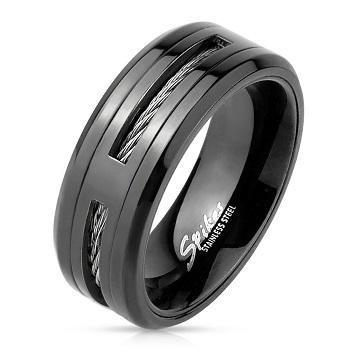
I know what you’re thinking… Isn’t stainless steel for appliances and medical instruments and such? Yup, but the trend in using stainless steel for jewelry - from the most delicate and intricate women’s jewelry to the manliest of man adornments - is steadily rising in popularity!
With that comes the question that usually arises when new forms of jewelry become readily available and affordable - is it really safe? Well, that depends.
Stainless steel jewelry that is made like medical grade stainless steel is perfectly safe to wear. An example would be 316L or 304 stainless steel. This is why we only have 316L stainless steel for our men's rings at Thinkengraved.
According to an article by Hulpf Jewelry, there is a lot of miscommunication when it comes to the toxic substances in jewelry. They go on to state that high-contamination in low-cost jewelry is a widespread problem in today’s times.
Furthermore, until recently, there were only regulations in place for the alloy nickel (Ni), which is found in a lot of lower cost jewelry.
However, there are other alloys that are just as, if not more, toxic than nickel - though nickel is the most common metal allergy today, which is why there were regulations in place for this particular metal.
Here is a short list of some of the toxic substances that may be found, though in small quantities, in low-cost jewelry including stainless steel.
Materials that are not safe in stainless steel.
Cadmium
[ref. https://www.osha.gov/SLTC/cadmium/]
Cadmium is a soft, bluish-white metal found in zinc. This metal is most often used in manufacturing, but exposure can occur in any industry. This metal is mainly used for batteries, coatings, solar cells, alloys, and pigments.
However, cadmium is also extremely toxic to those who are around it and this particular metal is known to cause certain forms of cancer as well as targets many different functions of the human bodies systems including the cardiovascular, renal, neurological, respiratory, and even reproductive systems.
[ref. https://www.ppai.org/media/1810/pr-bp-jewelry.pdf] According to PPAI (Promotional Products Association International), the current limit for cadmium in jewelry is < [less than] 75 parts per million.
Lead
Lead is another among the top, most toxic metals. Lead is especially dangerous for children, as it can stunt healthy bone growth, cause damage to the nervous system and kidneys, and can even cause developmental delays and other issues. Lead is most commonly found in lead-based paints and the manufacturing industry.
However, it can also be found in environmental places such as contaminated soil, water from old lead pipes and faucets, and some forms of toys and jewelry.
According to PPAI, the current limit for lead in jewelry is < 200 parts per million for substrates (which is an underlying substance or layer) and < 99 parts per million for surface coatings.
Nickel
Nickel is the most commonly focused on metal when it comes to jewelry because so many people have a hypersensitivity or allergy to it. This is also the most common low-cost yet toxic metal that is used to make various alloys and coatings for jewelry.
You can actually come in contact with nickel by simply eating and drinking because it’s so easily found in soils.
According to an article on Business Companion’s blog [ref. https://www.businesscompanion.info/en/quick-guides/product-safety/jewellery-safety-metal-content] there is evidence that suggests that an adverse reaction to nickel is less likely to occur at levels < 100 parts per million.
So, is it safe? Actually, yes. Stainless steel jewelry is covered and regulated by PPAI and other testing and inspecting organizations just like all other jewelry.
This means that, if a piece of jewelry does not meet these standards, it is not allowed to be sent out for retail. Just ensure to ask the jeweler what types of metals are known in the ring prior to purchase or look for a stamp on the ring.
To find out if the jewelry is something that you really want to buy, and is safe for you to wear if you have a nickel allergy, look out for jewelry marker 316L (surgical steel) or 304 stainless steel.
316L is surgical steel (the same type of steel used in surgical instruments). This type of steel has an extremely low nickel level, so it would be be okay for someone with a nickel allergy to wear., even just once and a while.
304 stainless steel is even better than 316L because the nickel content is even lower. 316L contains 10% nickel while the 304 stainless steel contains 8%. However, it’s important to note that the really huge difference between the two is the presence of molybdenum in the 316L, which provides a high amount of protection against corrosion.
For more information on how to interpret jewelry stamps, read this [ref. https://quickjewelryrepairs.com/jewelry-stamps-what-do-they-really-mean/] article on Quick Jewelry Repairs’ blog.
The Five Types of Stainless Steel
[ref. https://app.aws.org/wj/1998/11/kotecki/]
[ref. https://www.serenityinchains.com/blog/stainless-steel-nickel-free]
There are also three different variations of stainless steel and these are possibly more important to know then the latter due to the fact that some of these variations contain more nickel than others while other variations are actually less magnetic and will develop tarnish over time.
Martensitic
Martensitic stainless steel’s malleability depends heavily on how high the carbon content is. This is also a type that is slightly likely to develop rust and tarnish.
Ferritic
Ferritic stainless steel consists of iron-chromium alloys and can be found in a variety of products from mufflers, kitchen counters and sinks. Most ferritic stainless steel is subject to rust and tarnish.
Austenitic
Austenitic stainless steel is the most common and popular stainless steel due to it’s increased malleability compared to the other two. Austenitic steel can be divided into three main groups:
- Common chromium-nickel (300 series)
- Manganese-chromium-nickel-nitrogen (200 series)
- Specialty alloys
Duplex
This type of stainless steel is primarily used in chemical plants and piping. This particular type of stainless steel contains approximately 22-25% chromium and 5% nickel.
Precipitation Hardening
This type of stainless steel is chromium-nickel based. This is probably the worse type of nickel for jewelry considering its extremely high nickel content. This can also be divided into three main subgroups:
- Martensitic
- Semiautensitic
- Austensitic
How to Test if your Ring is Stainless Steel
There are a few ways to test if a ring is really stainless steel. The first, and easiest, way to test if your jewelry is true stainless steel is to simply hold it up to a magnet. Since stainless steel is magnetic it should stick to the magnet with ease. If it doesn’t, you may have some false stainless steel, such as aluminum, instead.
Another thing to keep an eye out for? Rust. Stainless steel usually doesn’t rust if its processed right, so if your jewelry is starting to look a little drab and rusty around the edges, you may have gotten a knock-off.
Two more fun and satisfying ways to check the authenticity of your stainless steel jewelry is to simply polish or tap your jewelry.
To polish it, all you’ll need is a soft cloth. Simply wipe the jewelry’s surface and check to see if you can see your reflection. If you can, it’s more than probably authentic. If you can’t, it’s probably aluminum or some other, cheaper metal.
Alternately, you can simply tap your jewelry with a penny or a brass key. If it makes a “ting” sound, that’s a good sign. If it makes more of a “clang” sound, then it’s most likely fake.
The Pros and Cons of Stainless Steel
Such as with everything. Stainless steel has its own set of pros and cons. These are important in making a decision when contemplating purchasing stainless steel jewelry. Here are only a few, more important pros and cons to be aware of when deciding if stainless steel jewelry is right for you.
Pros
- Stainless steel is highly durable which makes it ideal for working man’s jewelry or other active people.
- Stainless steel adds a touch of chic to almost anything due to its natural shine. It’s the next runner up to sterling silver!
- Stainless steel doesn’t rust or corrode, which makes it great jewelry to pair with outdoor activities and rainy days. No more worrying about ruining your look. You planned ahead!
- Stainless steel is super affordable compared to other types of jewelry on the market
Cons
- Though it’s a much more durable metal, that doesn’t mean that it’s invincible and it can
- Sizing stainless steel rings can be a hassle because of the metal’s natural rigidity, which also makes it harder to add in personalization such as gemstones or added designs.
- Stainless steel is known to contain nickel, which makes this a less than ideal choice for those who suffer from nickel allergies and metal hypersensitivity.
- It’s highly recommended that your kids do NOT play with any stainless steel jewelry on. Though stainless steel will break, it takes an immense amount of force. And, no one’s wants to rush Johnny to the hospital because his stainless steel necklace didn’t break when it got snagged on someone’s jersey.
So, we’ve gone over the substances that may or may not be found in trace amounts across, not just stainless steel jewelry, but most types of jewelry.
We’ve weighed the pros and cons, noted how to test its authenticity, and even how to check the nickel content of the jewelry you’re considering to purchase. The only thing now is to decide if stainless steel is the right pick for you.
If you suffer from a nickel allergy, it’s highly recommended that you look for jewelry that’s labeled as nickel free since this is the easiest way to determine if you’re going to have an allergic reaction to the metal.
Other metals such as high karat golds (above 14K), platinum, palladium, titanium, and tungsten usually contain little to no nickel and may be a safer option - though these types of metals and jewelry tend to be more expensive.
If you decide to purchase stainless steel jewelry, make sure to look for the stamp and ask to see if the jeweler knows what content of nickel is in the ring. As long as you don’t have a severe nickel allergy stainless steel is a completely safe, chic, and elegant option for affordable jewelry.
Be sure to check out our selection of 316L stainless steel personalized men's rings here
Here's some more article we think you will love.
How Long do Sterling Silver Rings Last?
How to Gift a Ring to a Boyfriend
How to tell if sterling silver is authentic.
Why should men wear promise rings?


2 comments
This is really great information found here, I really like your blog. Thanks very much for the share. Keep posting.
Nice article.
I’ve been researching into stainless steel, mainly 304 and 316L . From my research, 304 contains between 8-10.5% nickel and 316L has 10-13% nickel but, the nickel is mixed with other metals (alloy) and not plated.
In the EU (and UK) there is the EU Nickel Directive which states metal containing nickel cannot exceed “0.5 µg/cm2/week for products intended to come into direct and prolonged contact with the skin”, such as jewelry.
There have been several lab tests (documented online) using an alkaline solution (acidiphied artificial sweat) that conclude – “The following released levels of Ni from stainless steel in artificial sweat (pH 6.5) have been reported: (2) <0.03 µg/cm2 (1 week, grades AISI 304, 316L, and 430)” which is not only well under the EU Nickel Directive’s max exposure amount but basically causes no allergic reaction to those with “normal” nickel sensitivity.
So, 304 and 316L is safe to use in jewelry, even according to the EU Nickel Directive (which the US, as far as I know, doesn’t have such limitations/directives) but, that doesn’t mean people with very high sensitivity to nickel will not be affected.